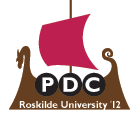| EXPL PAPERS | THURSDAY 11:45-12:45 | GRAND AUDITORIUM |
PD and Community
Session chair: Sara Eriksén, Blekinge Institute of Technology
Social innovation within prison service
Marie Kirstejn Aakjaer, The Danish School of Education
Eva Brandt, The Royal Danish Academy of Fine Arts
Abstract. This paper report on a project in a maximum-security prison in Denmark, where a group of officers and inmates engaged in a participatory design project aimed at improving the quality of everyday life. A series of participatory design workshops had two overall objectives: 1) to increase levels of trust and confidence in the prison, and 2) to learn how to engage inmates better in their everyday life inside prison, e.g. through engaging them in collective matters. The process of co-inquiry and co-creation provided a new social infrastructure, which allowed inmates and prison officers to access new roles and social positions.
From 'troublemakers' to problem solvers: Designing with youth in a disadvantaged neighbourhood
Martin Severin Frandsen, Roskilde University
Lene Pfeiffer Petersen, Roskilde University
Abstract. This paper presents the experiences and reflexions of a design practitioner working in the field of community development. The case illustrates how participatory design processes can contribute to social change. The paper tells a story of design process where youths from a local school in a disadvantaged neighbourhood in the suburbs of Copenhagen, designed and constructed colourful and imaginative dustbins to handle problems with local littering. The project was successful in creating an increased local awareness of waste management and reducing the amount of litter. However, the more important but less tangible result of the design process was the change it produced in the social relations in the neighbourhood. By giving them the opportunity to work as designers, the process contributed to a shift in the image of the youths from one of ‘troublemakers’ to a positive image of collaborative problem solvers.
What we talk about when we talk about co-creative tangibles
Jo Herstad, University of Oslo
Harald Holone, Østfold University College
Abstract. We investigate ways in which emergent digital technologies embedded into “soft things” offer new possibilities for communication, collaboration and co-creation between people with and without disabilities. Specifically, we look at ways in which tangible, net based, multimodal artifacts can be used for creating and sharing music and visuals. In this paper, we describe the notion of co-creative tangibles, and the ways in which different stakeholders talk about these “smart things”. The three participating groups are children and their families, care givers and teachers, and researchers from different disciplines. We will specifically investigate Universal Design in the area of Tangible Interaction, and ways of talking about the “things” we develop, use and interact with.
Outlining a participatory approach for using building renovation momentum for wider effects
Tero Heikkinen, Aalto University
Katja Soini, Aalto University
Sari Dhima, Aalto University
Abstract. This exploratory paper presents a freshly initiated research project for developing a model for approach for suburban renovation projects in Finland. The main focus is on the construction in suburbs that were built in the 1960s and 1970s and are now facing re-evaluation due to ensuing repairs and new energy use criteria. The chosen neighborhoods are also facing reputation issues and social problems. The plan is to exploit the momentum of the inevitable technical improvement projects to also benefit long-term improvement of the social and aesthetic quality of the environment as a whole. This means also discussing ways to redefine the scope of renovation with the service providers. Here a participatory design research approach could prove useful in finding effective means of communication between inhabitants, the local parties acting within the neighborhoods and the renovation service providers. The present research is based in part on past work revolving around plumbing renovation cases, where successes were achieved in activating various partners connected to the renovation projects. The intent is to extend and refine the practices developed in the past project. The project plan and proposed mode of approach will be presented in detail.
